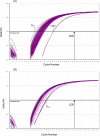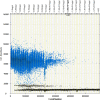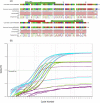Development and validation of a real-time PCR assay to detect Cannabis sativa in food
- PMID: 33637785
- PMCID: PMC7910487
- DOI: 10.1038/s41598-021-83908-4
Development and validation of a real-time PCR assay to detect Cannabis sativa in food
Abstract
Regarding the prospective investigation of food authenticity and adulteration the aim of the present study was the development and validation of a real-time PCR assay to identify hemp (Cannabis sativa) which has gained increasing importance as a valuable food ingredient. The assay targets a specific spacer DNA sequence in Cannabis sativa chloroplasts and detects 1.5 pg hemp DNA, which is equivalent to 18 copies/µL. Corresponding to the very low LOD (0.00031 ng/µL) the method allows the detection of hemp even in the infinitesimal concentration of contaminants. Due to a SNP in position 603, hemp can be identified unequivocally and discriminated from its closest relative hops (Humulus lupulus). The PCR method shows no cross-reactivity with 39 of 46 tested plant species. Low cross-reactivity with mulberry, stinging nettle, lavender, cornflower, wine, figs and hops can be neglected, because the Δ Ct-values are > 14, and the obtained Ct-values are beyond the cut-off for a positive assessment (Ct-values ≤ 33). Moreover, the suitability of the method to identify hemp as a food ingredient was proved by analysing diverse food products such as chocolate or cookies.
Conflict of interest statement
The authors declare no competing interests.
Figures






Similar articles
-
The complete chloroplast genomes of Cannabis sativa and Humulus lupulus.Mitochondrial DNA A DNA Mapp Seq Anal. 2016 Sep;27(5):3793-4. doi: 10.3109/19401736.2015.1079905. Epub 2015 Sep 2. Mitochondrial DNA A DNA Mapp Seq Anal. 2016. PMID: 26329384
-
Development of a real-time PCR assay for detection of hemp russet mite (Aculops cannabicola).Environ Entomol. 2024 Feb 20;53(1):34-39. doi: 10.1093/ee/nvad060. Environ Entomol. 2024. PMID: 37535869
-
The Genomics of Cannabis and Its Close Relatives.Annu Rev Plant Biol. 2020 Apr 29;71:713-739. doi: 10.1146/annurev-arplant-081519-040203. Epub 2020 Mar 10. Annu Rev Plant Biol. 2020. PMID: 32155342
-
Hemp Seeds (Cannabis sativa L.) as a Valuable Source of Natural Ingredients for Functional Foods-A Review.Molecules. 2024 May 1;29(9):2097. doi: 10.3390/molecules29092097. Molecules. 2024. PMID: 38731588 Free PMC article. Review.
-
Hemp (Cannabis sativa subsp. sativa) Chemical Composition and the Application of Hempseeds in Food Formulations.Plant Foods Hum Nutr. 2022 Dec;77(4):504-513. doi: 10.1007/s11130-022-01013-x. Epub 2022 Sep 16. Plant Foods Hum Nutr. 2022. PMID: 36112300 Review.
Cited by
-
Foodomics as a Tool for Evaluating Food Authenticity and Safety from Field to Table: A Review.Foods. 2024 Dec 25;14(1):15. doi: 10.3390/foods14010015. Foods. 2024. PMID: 39796305 Free PMC article. Review.
-
Identifying a suspect powder as a cannabis concentrate through chemical analysis and DNA testing.Forensic Toxicol. 2024 Jan;42(1):102-109. doi: 10.1007/s11419-023-00672-y. Epub 2023 Aug 21. Forensic Toxicol. 2024. PMID: 37603166
-
Modified "Allele-Specific qPCR" Method for SNP Genotyping Based on FRET.Front Plant Sci. 2022 Jan 10;12:747886. doi: 10.3389/fpls.2021.747886. eCollection 2021. Front Plant Sci. 2022. PMID: 35082803 Free PMC article.
References
-
- European Parliament and Council. Regulation (EU) No 1307/2013 of the European Parliament and of the Council (2013). https://eur-lex.europa.eu/legal-content/EN/TXT/HTML/?uri=CELEX:32013R130.... Accessed 28 Oct 2019.
-
- Matthäus B, Brühl L. Virgin hemp seed oil: an interesting niche product. Eur. J. Lipid Sci. Technol. 2008;10:655–661. doi: 10.1002/ejlt.200700311. - DOI
-
- Oomah BD, Busson M, Godfrey DV, Drover JCG. Characteristic of hemp (Cannabis sativa L.) seed oil. Food Chem. 2002;76:33–43. doi: 10.1016/S0308-8146(01)00245-X. - DOI
-
- Deferne JL, Pate DW. Hemp seed oil: a source of valuable essential fatty acids. IHA. 1996;3:4–7.
MeSH terms
Substances
LinkOut - more resources
Full Text Sources
Other Literature Sources
Research Materials
Miscellaneous

